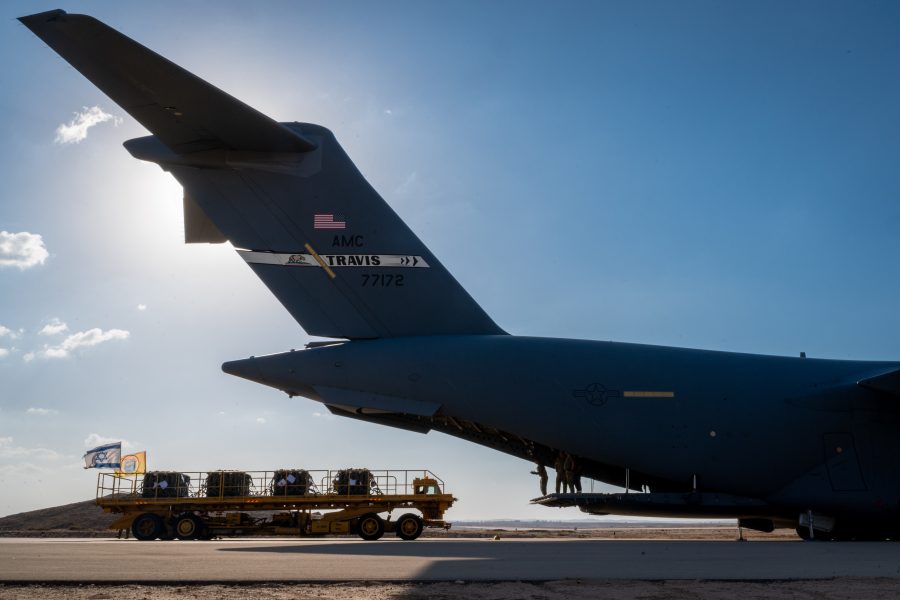NATIONAL HARBOR, Md.—Hamas’ deadly attack on Israel nearly one year ago caught the world by surprise—including Gen. Jacqueline D. Van Ovost, the U.S. military’s top logistics officer.
But the Oct. 7 crisis, which spiraled into a war now on the cusp of its second year, illuminated fresh lessons in emergency response and threat avoidance as U.S. Transportation Command scrambled to protect American troops in the Middle East, initiate aid airdrops, and keep ships moving through the region’s waterways, Van Ovost told reporters Sept. 17 at AFA’s Air, Space and Cyber Conference here.
“With any crisis, the three things I look at [are], what’s my posture, what’s my capacity to respond, and how do I command and control and integrate into the joint force commander’s needs?” she said. “I think we did a really good job.”
The time crunch forced TRANSCOM to prioritize what mattered most—in this case, loading Patriot air defense missile systems onto several C-17 Globemaster III airlifters and getting them “up and radiating,” Van Ovost said.
While the U.S. military needed about a dozen C-17s to rush troops and equipment to the region, logistics planners soon learned that shipping the most critical piece—air defenses—would only require about seven jets. So TRANSCOM revamped its plans to instead put the basics into theater first and worry about sending extra generators and other equipment later, Van Ovost said.
That scramble came as the U.S. rushed extra military aid to Israel, including ammunition and Iron Dome interceptors, while American combat units deployed across U.S. Central Command to prepare for the possibility of a wider war.
“We learned that we could actually repackage something on the fly and get capabilities sooner,” Van Ovost said. “I’ve turned to the services and said, ‘That’s an example of how to ‘deploy to employ’ in a very short period of time. I promise you I’ll come back and get the rest.’”
That approach could become a cornerstone of the U.S. military’s effort to inject more flexibility into its deployments and use limited resources more judiciously, known as “agile combat employment.” Those plans, which span ideas from training troops to handle multiple jobs at once to launching operations away from large centralized bases, aim to make American forces harder to target and more resilient under attack.
Months of unrelenting attacks by Houthi rebels in Yemen on commercial shipping vessels and U.S. military assets—namely, the USS Dwight D. Eisenhower aircraft carrier—also forced the U.S. to get creative to ensure commercial goods and military materiel could reach their destinations.

TRANSCOM “immediately” began meeting with its commercial sealift partners and sent a team of tactical advisors to the Navy’s Middle East headquarters in Bahrain, Van Ovost said.
“They set up a crisis node for all of our commercial partners to give them information: Should they come in through the Suez Canal? Should they go around the Cape [of Good Hope]? Are they coming out of the Persian Gulf? … What’s the threat?” she said.
Then the U.S. began orchestrating convoys and meeting up with commercial vessels to protect them as they passed. That built on years of training commercial companies to zigzag at sea to become more difficult to target, among other force protection measures, Van Ovost said.
Iran-backed Houthi rebels had targeted more than 70 vessels with missiles and drones between October 2023 and mid-July 2024, seizing one vessel and sinking two, the AP reported.
Adding tactical advisers and communications equipment to commercial shipping let crews speak to U.S. destroyers more easily without the typical maritime signaling.
That assistance underscored a difficult point: “We learned that choke point, as small as it is, if you have a persistent threat, it can take a lot of resources to move stuff through,” Van Ovost said.
Those lessons on flexibility and situational awareness echo what TRANSCOM has learned in the first two years of Russia’s war in Ukraine as well.
Asked what she believes is the most difficult piece of equipment the U.S. has shipped to Ukraine, Van Ovost pointed to ammunition. The State Department said Sept. 6 the U.S. has sent nearly 100,000 rounds of long-range artillery and nearly 250,000 anti-tank munitions to Ukraine so far, among more than $25 billion in other weapons, aircraft, tanks, and other materiel.
“We did move a lot of hazardous [material], from a depot on a road, to an airport, or a seaport, to a port, to a train, to a new way to get into Ukraine,” Van Ovost said. “I think the hardest thing was linking all those pieces together, because nobody wanted to stockpile anywhere.”
That reflects a key concern of agile combat employment, which aims to preposition equipment in and around potential war zones without leaving it vulnerable to attack. Van Ovost said the U.S. is learning from Ukraine’s ability to adapt and move military shipments across the country while under fire every day.
Toting large quantities of explosives across the U.S. and Europe has posed another unique challenge, the four-star said. Ports limit how many explosives can travel through at a given time to lessen the risk of a deadly accident, forcing Ukraine’s benefactors to rush aid swiftly but methodically.
“If a train slowed down somewhere, we knew about it: ‘Should we go to another seaport instead of this seaport?’” Van Ovost said. “We’re constantly looking at those things.”
The Pentagon needs to boost its investment in data-crunching and communications tools that can give commanders real-time insights into where people and equipment are at any given time, fuel levels, and other critical aspects of the supply chain.
Air Mobility Command has laid the groundwork for broad adoption of comms kits on transport and tanker jets with its “25 in ’25” initiative, meant to add those kits to 25 percent of the mobility fleet by 2025. It will fall short of that goal, however.
“That’s not where I wanted it to be,” Van Ovost said of funding for modern communications tools. “We’ll continue to request that, if we’re going to fight … in a contested environment, I’ve got to have the connectivity to do that.”
